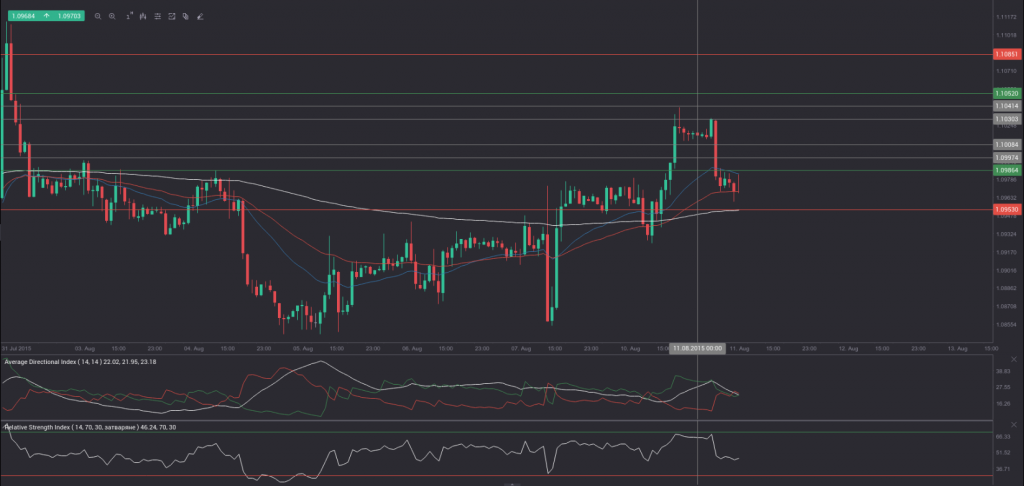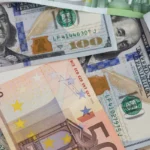Yesterday’s trade saw EUR/USD within the range of 1.0924-1.1044. The pair closed at 1.1019, soaring 0.55% on a daily basis, or the most considerable daily gain since July 27th, when it appreciated 1.11%. The daily high has also been the highest level since July 31st, when the cross reached a high of 1.1114.
At 6:41 GMT today EUR/USD was down 0.46% for the day to trade at 1.0968. The pair touched a daily low at 1.0961 at 5:55 GMT in an attempt to test the lower range breakout level (S4).
Today the cross may be influenced by a number of macroeconomic reports as listed below.
Fundamentals
Euro area
Italian Consumer Inflation – final estimate
Italys final annualized consumer inflation probably matched the preliminary inflation estimate of 0.2% in July, which was reported on July 31st. In June the final annualized index of consumer prices (CPI) rose 0.2%, exceeding the preliminary estimate of a 0.1% annual CPI growth. According to provisional data, in July the largest annual price increase was reported for alcoholic beverages and tobacco (up 3%, which matched the rate reported in June), restaurants and hotels (up 1.3%, following a 1.6% increase in June) and food and non-alcoholic beverages (up 0.7%, following a 1.0% gain in the prior month). On the other hand, downward pressure came from costs of communication (down 3.2%, following another 2.1% slump in June), transport costs (down 1.8% year-on-year, following a 1.6% drop in June) and housing and utilities costs (down 0.3%, following a 1.3% decrease in June).
Key categories, included in Italys Consumer Price Index, are food and non-alcoholic beverages (accounting for 16% of total weight), transport (15%), restaurants and hotels (11%) and housing, water, electricity and other fuels (10%). Other categories are clothing and footwear (9%), furnishing and household equipment (8%), recreation and culture (8%) and health (also 8%). Communication, education, alcoholic beverages, tobacco and other goods and services comprise the remaining 15% of the index.
The nations final annualized CPI, evaluated in accordance with the harmonized methodology, probably increased 0.4% in July, according to market expectations. If so, this would match the preliminary HICP estimate, reported on July 31st, and would also be the largest annual HICP gain since May 2014, when the index climbed 0.4%. In May and June 2015 the final annualized HICP rose at a pace of 0.2%, which confirmed the provisional estimates. The National Institute of Statistics (Istat) is to release the official CPI report at 8:00 GMT.
German, Euro zone Economic Sentiment Index by ZEW
The gauge of economic sentiment in Germany probably rebounded in August to reach 32.0, according to the median forecast by experts. In July the index slipped to a reading of 29.7, which has been the lowest value since November 2014, when the gauge came in at a level of 11.5.
The ZEW (Zentrum für Europäische Wirtschaftsforschung) economic expectations index is reported on a monthly basis. The study encompasses up to 350 financial and economic analysts. The indicator reflects the difference between the share of analysts, that are optimistic and those, that are pessimistic about the expected economic development in Germany over the next six months. A positive value indicates that the proportion of optimists is larger than that of pessimists. A ZEW reading of -100 suggests that all analysts are pessimistic about the current developments and expect economic conditions to deteriorate. A ZEW reading of 100 implies that all analysts are optimistic about the current situation and expect conditions to improve. A ZEW reading of 0 indicates neutrality.
The index of current assessment in Germany probably improved for a second consecutive month in August, reaching a value of 64.5, according to market expectations. If so, this would be the highest index reading since May 2015, when a level of 65.7 was reported. The gauge stood at 63.9 in July.
The ZEW Economic Sentiment index for the whole Euro zone probably rebounded in August to reach 43.9, according to market expectations. In July the gauge was reported at 42.7, which has been the lowest level since December 2014, when the index slid to 31.8.
In case the German gauge of economic sentiment improved at a sharper pace than expected, this would certainly have a positive impact on the common currency. The official data is scheduled to be released at 9:00 GMT.
United States
Fed Vice Chair Fischers remarks
The US dollar was quite dynamic in late European trade on Monday, following the remarks made by Federal Reserve Vice Chair Stanley Fischer.
“We are in a situation with … nearly full employment but very low inflation”, Fischer noted in an interview for Bloomberg TV. “A large part of the current inflation is temporary. It has to do with the decline in the price of oil; it has to do with the decline in the price of raw materials,” he said.
According to Fischer, Fed policy makers “would be happier if we saw more physical investment than financial investment” in times of accommodative monetary policy.
Bond Yield Spread
The yield on German 2-year government bonds went as high as -0.254% on August 10th, after which it slid to -0.265% at the close to lose 0.004 percentage point on a daily basis, while marking a third straight day of decrease.
The yield on US 2-year government bonds climbed as high as 0.741% on August 10th, after which it fell to 0.729% at the close to gain 0.008 percentage point for the day.
The spread between 2-year US and 2-year German bond yields, which reflects the flow of funds in a short term, expanded to 0.994% on August 10th from 0.982% on August 7th. The August 10th spread has been the most notable one in at least two months.
Meanwhile, the yield on German 10-year government bonds soared as high as 0.708% on August 10th, after which it slid to 0.705% at the close to gain 4.7 basis points (0.047 percentage point) compared to August 7th. It has been the first increase in the past three trading days.
The yield on US 10-year government bonds climbed as high as 2.243% on August 10th, after which it slipped to 2.232% at the close to add 6.6 basis points (0.066 percentage point) on a daily basis, while marking the first gain in the past three trading days.
The spread between 10-year US and 10-year German bond yields widened to 1.527% on August 10th from 1.508% on August 7th. The August 10th yield difference has been the largest one since August 4th, when the spread was 1.587%.
Daily and Weekly Pivot Levels
By employing the Camarilla calculation method, the daily pivot levels for EUR/USD are presented as follows:
R1 – 1.1030
R2 – 1.1041
R3 (range resistance – green on the 1-hour chart) – 1.1052
R4 (range breakout – red on the 1-hour chart) – 1.1085
S1 – 1.1008
S2 – 1.0997
S3 (range support – green on the 1-hour chart) – 1.0986
S4 (range breakout – red on the 1-hour chart) – 1.0953
By using the traditional method of calculation, the weekly pivot levels for EUR/USD are presented as follows:
Central Pivot Point – 1.0938
R1 – 1.1029
R2 – 1.1089
R3 – 1.1180
S1 – 1.0878
S2 – 1.0787
S3 – 1.0727






